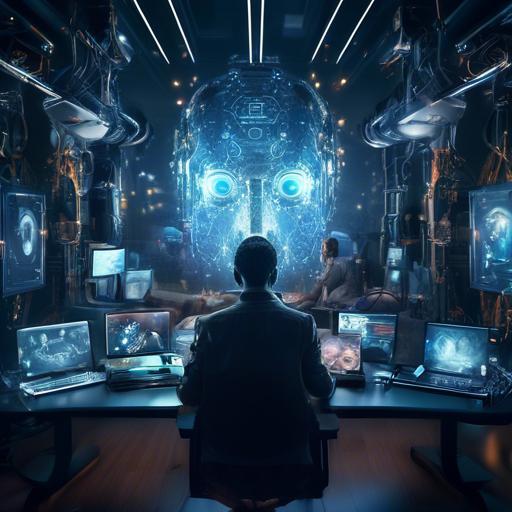In an era where the digital canvas is ever-expanding, and the demand for crisp, high-definition imagery is at an all-time high, one technological innovation is poised to revolutionize the way we perceive visual content: Image Super-Resolution powered by Artificial Intelligence (AI). Imagine a world where every photograph you cherish, every frame of video you capture, and every scan of historic documents can be enhanced to reveal astonishing clarity, previously thought impossible. This isn’t a distant dream but a rapidly advancing reality. In the pages that follow, we will embark on a fascinating journey through the realm of AI-driven image super-resolution, illuminating how this cutting-edge technology is transforming pixels into masterpieces and pixels into profound visual experiences. Ready to see your images in a whole new light? Let’s dive in.
Table of Contents
- Unlocking the Potential of AI in Enhancing Image Quality
- Exploring the Techniques Behind AI-Powered Super-Resolution
- How Neural Networks are Transforming Image Clarity
- Key Algorithms Driving AI-Based Image Enhancement
- Practical Applications of Image Super-Resolution in Various Industries
- Overcoming Common Challenges in AI-Enhanced Imaging
- Best Practices for Implementing AI Super-Resolution Solutions
- Future Trends: Where AI Image Super-Resolution is Headed
- Ethical Considerations in the Use of AI for Image Enhancement
- Future Outlook
Unlocking the Potential of AI in Enhancing Image Quality
The advent of Artificial Intelligence has revolutionized various fields, and image enhancement is no exception. By applying machine learning algorithms, AI can significantly improve the quality of images, transforming low-resolution pictures into high-definition works of art. These capabilities are powered by sophisticated neural networks that analyze and reconstruct images with impressive accuracy.
One of the primary benefits of utilizing AI for image enhancement is its ability to fill in the gaps where data is lacking. Through advanced techniques such as **Convolutional Neural Networks (CNNs)**, AI can predict and create missing pixels, making the final output incredibly realistic. This allows for an array of applications ranging from medical imaging to restoring historical photos.
- Enhanced Detail: AI can amplify the smallest of details that would be lost in a traditional upscaling process.
- Noise Reduction: Smart algorithms can remove unwanted noise without sacrificing image quality.
- Faster Processing: Real-time enhancements are becoming feasible, making this technology viable for live video applications.
| Feature | Description |
|---|---|
| Deep Learning | Utilizes neural networks to improve image resolution |
| Real-time Upscaling | Enhances video quality on-the-fly |
| Adaptive Filtering | Applies context-aware filters to fine-tune images |
Moreover, AI’s capability to recognize patterns and textures enhances its versatility in image enhancement. Whether it’s refining the textures in a fabric or highlighting intricate details in a landscape, the technology excels at making images look lifelike. This not only enriches the visual experience but also opens up new realms of creativity for artists and designers alike.
integrating AI into the process of image enhancement holds immense promise. From **transforming ordinary visuals** into stunning representations to enabling real-time applications, the potential is limitless. The convergence of AI and image super-resolution is not just a technical advancement; it is a gateway to a more visually enriched future.
Exploring the Techniques Behind AI-Powered Super-Resolution
At the heart of AI-driven super-resolution lies an array of sophisticated techniques designed to enhance image quality beyond conventional means. These methods leverage deep learning and neural networks to reconstruct high-resolution images from low-resolution counterparts, delivering stunning results that were once thought impossible.
Convolutional Neural Networks (CNNs) play a pivotal role in this process. They are designed to recognize patterns within an image by applying a series of convolutional filters. This helps in capturing key features like edges, textures, and intricate details. Often, multiple layers of CNNs are utilized to progressively refine the image, effectively reconstructing higher levels of detail.
The typical steps involved are:
- **Feature extraction**: Initial layers detect basic patterns.
- **Non-linear mapping**: Intermediate layers combine these patterns to understand complex structures.
- **Reconstruction**: Final stages enhance the resolution by predicting high-resolution pixel values.
Another innovative approach is the use of **Generative Adversarial Networks (GANs)**. GANs consist of two competing networks – the generator and the discriminator. The generator aims to create realistic high-resolution images, while the discriminator evaluates the quality of these images. Over time, this adversarial process fine-tunes the network, producing remarkably lifelike results.
Below is a comparative overview of some common techniques:
| **Technique** | **Strengths** | **Challenges** |
|---|---|---|
| **CNNs** | Excellent at feature extraction, scalable | Requires large datasets, computationally intensive |
| **GANs** | Generates high-quality, realistic images | Training can be unstable, requires balancing networks |
| **Autoencoders** | Efficient data compression, anomaly detection | May miss out on fine details |
**Transfer Learning** is another powerful technique, particularly useful when labeled data is scarce. By leveraging pre-trained models on large datasets, one can fine-tune these models for specific super-resolution tasks, leading to higher efficiency and accuracy.
By meticulously applying these techniques, AI-driven super-resolution can significantly enhance image clarity, offering transformative benefits across various fields such as medical imaging, satellite imagery, and even restoring old photographs. The seamless integration of these advanced methodologies showcases the incredible potential and versatility of artificial intelligence in elevating our visual experiences.
How Neural Networks are Transforming Image Clarity
Recent advancements in neural networks have opened new frontiers in the realm of image clarity, bringing us closer to what was once science fiction. This sophisticated AI technology is particularly adept at **image super-resolution**—the process of enhancing the resolution of an image to unveil details once thought irretrievable. One fascinating application is in photography, where grainy, low-resolution photos can now be transformed into high-definition masterpieces, capturing nuances such as individual hairs and intricate patterns.
So how do neural networks achieve this feat? The secret lies in their ability to learn and predict. They are trained using a vast dataset of high and low-resolution image pairs. Once trained, these networks can generate missing pixel information for new, unseen images. Here are some of the **key benefits**:
- Enhanced Detail: Restores fine details in images, making them appear sharp and lifelike.
- Reduced Noise: Minimizes unwanted distortions and noise in photographs.
- Better Zoom: Allows you to zoom into pictures without losing clarity.
Neural networks also excel in specialized fields, such as medical imaging and satellite imagery, where clarity is crucial for accurate analysis. For instance, doctors can now obtain enhanced images of scans, leading to better diagnoses and treatment plans. Meanwhile, clearer satellite images offer more precise monitoring of environmental changes and urban development.
Below is a simplified comparison that highlights the improvements achieved through neural networks:
| Aspect | Traditional Methods | Neural Networks |
|---|---|---|
| Detail Restoration | Moderate | High |
| Noise Reduction | Low | High |
| Zoom Quality | Poor | Excellent |
Clearly, the implications are vast and transformative. Whether in personal photography or professional fields, neural networks are revolutionizing the way we perceive and enhance images, offering us a clearer, more detailed view of the world around us.
Key Algorithms Driving AI-Based Image Enhancement
One of the significant algorithms fueling the advancement in image super-resolution is the Convolutional Neural Network (CNN). CNNs are designed to effectively recognize and classify patterns within images. These networks can learn spatial hierarchies of features through backpropagation algorithms, making them particularly adept at improving image resolution. By leveraging multiple layers, CNNs capture fine details and textures, thus producing highly accurate high-resolution images from low-resolution inputs.
A recent innovation in the realm of AI-driven image enhancement is Generative Adversarial Networks (GANs). GANs consist of two dueling networks: the generator, which attempts to create realistic high-resolution images, and the discriminator, which strives to distinguish between real and generated images. This competitive framework compels the generator to produce more authentic images over time, enabling the creation of exceptional high-resolution images that are often indistinguishable from the original high-quality photographs.
Here’s a comparison of CNNs and GANs in terms of their applications in image enhancement:
| Algorithm | Strength | Common Application |
|---|---|---|
| CNNs | Detail Extraction | Image Classification, Object Detection |
| GANs | Realism | Image Generation, Super-Resolution |
Another vital algorithm that bolsters AI-based image enhancement is the Recurrent Neural Network (RNN). While traditionally used for sequence data such as text, RNNs are now being applied to image processing tasks. They excel at capturing temporal dependencies and can be particularly useful when dealing with images that have sequential structures. For example, RNNs can be used to refine a series of video frames to enhance the resolution of each frame progressively.
In tandem with these algorithms, cutting-edge techniques like Transfer Learning are being utilized to fast-track the enhancement processes. Transfer Learning involves taking a pre-trained model, perhaps trained on extensive datasets for image recognition, and fine-tuning it for specific image enhancement tasks. This approach not only reduces computational time but also significantly boosts the accuracy and quality of the final output.
By harnessing the power of these sophisticated algorithms, we are witnessing unprecedented advancements in AI-powered image super-resolution. The collaboration of CNNs, GANs, RNNs, and Transfer Learning is revolutionizing the way we perceive and interact with visual content, opening new horizons for various applications, from medical imaging to entertainment.
Practical Applications of Image Super-Resolution in Various Industries
In the world of healthcare, AI-driven image super-resolution technology has transformative potential. Medical imaging, such as MRI and CT scans, can greatly benefit from heightened image clarity. **Enhanced diagnostics** allow doctors to identify minute anomalies that might be overlooked in lower-resolution images. Additionally, improved imagery aids in **precision surgeries**, helping surgeons navigate complex procedures with greater accuracy and confidence.
The entertainment industry is also leveraging this innovative technology to breathe new life into old content. **Film restoration** projects utilize image super-resolution to convert grainy, low-resolution footage into crisp, high-definition videos. This not only preserves our cinematic heritage but also introduces classic films to new audiences in a visually appealing format. **Streaming services** are increasingly using super-resolution algorithms to enhance video quality dynamically, ensuring viewers enjoy a seamless, high-definition experience irrespective of their network bandwidth.
| Industry | Application | Benefit |
|---|---|---|
| Healthcare | Medical Imaging | Accurate Diagnosis |
| Entertainment | Film Restoration | Clear-HD Videos |
| Aerospace | Satellite Imaging | Detailed Earth Observation |
In the aerospace sector, satellite imagery enhanced through image super-resolution technology ushers in new possibilities. **Detailed Earth observations** are critical for environmental monitoring, urban planning, and disaster management. By converting blurry satellite images into sharp, high-resolution visuals, scientists and researchers can make more informed decisions, identify changes in the environment, and respond efficiently to natural disasters.
Retail and e-commerce companies are adopting this cutting-edge technology to improve product presentation and consumer experience. **Product images** on e-commerce platforms can be upscaled to high resolution, providing customers with detailed visuals that drive purchase decisions. Additionally, **visual search engines** use super-resolution to better match product images with search queries, enhancing the accuracy and relevance of search results.
Another exciting application is in the field of **automotive and autonomous driving**. High-resolution images from cameras and sensors are crucial for the reliability and safety of self-driving cars. Super-resolution technology enhances these images, allowing the vehicle’s AI systems to better interpret and interact with the environment, improving navigation, and reducing the likelihood of accidents.
Overcoming Common Challenges in AI-Enhanced Imaging
Embarking on the journey to achieve high-quality image super-resolution through AI inevitably comes with its set of challenges. However, by identifying and addressing these common hurdles, one can proficiently harness the power of AI in enhancing imagery.
Data Quality and Quantity: One of the biggest obstacles faced is the availability of high-quality training data. **AI models** require extensive datasets to learn effectively. Here are a few approaches to mitigate this:
- **Data Augmentation:** Utilize techniques like rotation, scaling, and flipping to create variations of existing images.
- **Synthetic Data Generation:** Employ tools to simulate high-resolution images, effectively expanding your dataset.
- **Transfer Learning:** Leverage pre-trained models that have already learned to recognize and enhance image features.
Computational Resources: AI-enhanced imaging demands significant processing power, which can be a roadblock for many. Overcome this by:
- **Cloud-based Solutions:** Utilize cloud services that offer **GPU and TPU** resources for handling large-scale image processing.
- **Optimized Algorithms:** Implement algorithms that are specifically designed to be computationally efficient.
Model Interpretability: Understanding how AI models make decisions can be quite challenging. Foster transparency by:
- **Visual Explanations:** Use visualization tools to interpret how models respond to different image features.
- **Layer-wise Inspection:** Analyze individual layers within the neural network to comprehend their functions.
| Challenge | Solution |
|---|---|
| Data Quality | Data Augmentation, Synthetic Data Generation |
| Computational Resources | Cloud-based Solutions, Optimized Algorithms |
| Model Interpretability | Visual Explanations, Layer-wise Inspection |
Addressing these common challenges lays the groundwork for successfully integrating AI into image super-resolution. With strategic planning and the right tools, the potential for creating visually stunning, high-resolution images becomes not only a possibility but a thriving reality.
Best Practices for Implementing AI Super-Resolution Solutions
To maximize the benefits of AI-driven super-resolution, it’s paramount to follow industry best practices. These guidelines not only ensure the optimal performance of your solutions but also enhance their reliability and efficiency.
- Data Quality Management: The backbone of any AI application is the quality of training data. Use high-resolution, clean, and well-annotated images to train your models. Proper data preprocessing, including normalization and augmentation, can significantly boost your model’s performance.
- Model Selection: Choose a suitable AI model based on your specific needs. Explore options like SRCNN, EDSR, or GAN-based methods. A thorough evaluation of each model in terms of performance, speed, and scalability should guide your decision.
- Algorithm Optimization: Implement techniques such as pruning, quantization, and parallel processing. These optimizations not only enhance the speed but also reduce the computational load, making your solution more efficient.
Incorporating a robust evaluation strategy is crucial in understanding the true value of your AI super-resolution efforts. Utilize both quantitative metrics and qualitative assessments to gauge performance. Quantitative metrics include:
| Metric | Description |
|---|---|
| Peak Signal-to-Noise Ratio (PSNR) | Measures the ratio between the maximum possible power of an image and the power of corrupting noise. |
| Structural Similarity Index (SSIM) | Assesses the similarity between two images based on luminance, contrast, and structure. |
| Mean Squared Error (MSE) | Determines the average squared difference between estimated values and actual values. |
Beyond technical aspects, consider the **user experience**. Ensure that your solution is user-friendly and intuitive. Providing clear instructions, seamless integration options, and exemplary customer support can significantly enhance user satisfaction. Pay attention to feedback and be ready to iterate on your solution to meet user expectations.
maintain **transparency and ethical standards**. Ensure users are aware of data usage policies, the limitations of your solution, and how it handles sensitive information. Building trust through transparent practices is essential for long-term success.
Future Trends: Where AI Image Super-Resolution is Headed
As AI continues to evolve, the field of image super-resolution is poised to experience transformative changes. One of the most promising trends is the refinement of Generative Adversarial Networks (GANs). These networks are making it possible to create highly detailed images from low-resolution counterparts by predicting and filling in the missing data with astounding accuracy. Future advancements will likely see GANs becoming even more sophisticated, bringing us closer to near-photorealistic results.
Another exciting development on the horizon is the integration of **quantum computing** with AI algorithms. Quantum algorithms can process vast amounts of data at unprecedented speeds, making the process of image enhancement faster and more efficient. Imagine a future where super-resolution is not just a tool for professionals but a seamless part of everyday consumer devices.
- Higher Precision: Enhanced accuracy and detail in rendered images.
- Faster Processing: Quantum computing could drastically reduce rendering times.
- Ubiquitous Access: Super-resolution capabilities integrated into smartphones and consumer electronics.
Collaboration is also set to play a crucial role. Researchers and developers in diverse fields such as medicine, astronomy, and filmmaking are likely to join forces, leveraging the unique capabilities of AI-enhanced imaging to solve complex problems. This multidisciplinary approach will lead to innovations that can benefit multiple sectors.
| Sector | Future Application |
|---|---|
| Healthcare | Enhanced MRI and CT scans |
| Entertainment | Ultra-high-definition visuals in gaming and films |
| Astronomy | Clearer, more detailed images of celestial phenomena |
Lastly, the democratization of AI tools is inevitable. As technologies advance, we’ll see an array of user-friendly applications and platforms offering AI image super-resolution. This will enable hobbyists, educators, and small businesses to access sophisticated image enhancement techniques previously reserved for specialized industries.
Ethical Considerations in the Use of AI for Image Enhancement
With the rising influence of artificial intelligence in image enhancement, numerous ethical questions have emerged. These act as guiding principles to ensure that the use of such technology aligns with societal norms and individual rights.
Transparency and Consent: Users have the right to know when AI is used to enhance images. This adds a layer of transparency and respects the user’s consent. It’s vital to clearly communicate if an image has been digitally altered using AI to prevent potential deception.
- **Disclosure:** Always inform viewers that AI enhancements have been applied.
- **Permission:** Obtain explicit consent before applying AI enhancements to someone’s image.
- **Ethical Marketing:** Ensure transparency in commercial advertising where enhanced images are used.
Accuracy vs. Manipulation: While AI can significantly improve image quality, it must tread the fine line between enhancement and manipulation. The tool should be used to improve clarity and visual appeal without distorting reality or misleading the viewer.
| Scenario | Action |
|---|---|
| Enhancing historical images | Improve clarity without altering original details |
| Social media posts | Disclose enhancements to avoid unrealistic standards |
| Medical imaging | Utilize accurately for better diagnostics |
Bias and Fairness: AI models can inadvertently inherit biases present in their training data. Ensuring that image enhancement tools do not disproportionately benefit or disadvantage any group is crucial for ethical use. Regular audits and diversified datasets can help mitigate this risk.
ethical considerations form the backbone of responsible AI usage in image enhancement. By prioritizing transparency, accuracy, and fairness, we can harness the power of AI while maintaining trust and integrity in our visual content.
Future Outlook
the potential of leveraging AI for image super-resolution is truly revolutionary. As technology continues to advance, we are only beginning to scratch the surface of what is possible. With the power of AI, we can enhance our visual experiences to new heights and unlock a world of infinite possibilities. So let’s continue to explore, innovate, and push the boundaries of what is conceivable with AI, because the future is bright and the opportunities are limitless. Let’s embrace the transformative power of AI and together, let’s create a world where every pixel is a masterpiece.
































